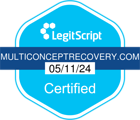Everyone will have moments where they feel anxious or fearful of a situation. These feelings are a normal and natural response to certain events in our daily lives. However, there are some who experience sudden attacks of anxiety that last several minutes and feel overwhelmed with fear. These short but intense moments of gripping fear and anxiety are known as panic attacks. These attacks often come without warning and lower one’s quality of life. Worse yet, panic attacks significantly affect work, school, and family life.
While panic attacks can feel debilitating, they can be controlled if you know the signs, symptoms, and proper coping techniques. This article will define panic attacks, their causes, and their symptoms. You will also learn about coping strategies, so you know what to do during a panic attack.
What is a Panic Attack?
Simply defined, a panic attack is a feeling of fear that is both sudden and intense. They are characterized by an overwhelming fear of disaster even if there is no danger present. These attacks can last for several minutes and can arise with little or no warning. Because these attacks can happen anytime and anywhere, people who suffer from them constantly worry about the next attack.
Many people will experience a panic attack at some point in their lives. In most cases, these dissipate once the event that precipitated the attack diminishes, and people may never experience another one. However, if people have recurring cases of unexpected panic attacks and live in fear of when the next one comes, it is a condition that must be treated in order for them to lead a productive and healthy life.
What Causes Panic Attacks?
The causes of panic attacks have psychological and environmental roots. The psychological roots of panic attacks can include chronic stress, existing mental health conditions such as ADHD and anxiety, and existing phobias which can trigger an intense fear response. Additionally, people who are prone to panic attacks may have low self-esteem or passively engage with others.
Regarding environmental causes of panic attacks, people who suffer a profound loss, such as the death of a loved one, are more susceptible to a panic attack. People who experience significant life changes such as losing a job or partner are more likely to experience a panic attack. Also, chronic panic attacks are seen in people who avoid certain situations and keep feelings “bottled up.”
Symptoms of Panic Attacks
The symptoms of a panic attack can be broken down into physical signs and emotional symptoms. The psychological symptoms of a panic attack can include the following:
- Nausea
- Vomiting
- Heart palpitations
- Chest pain
- Dizziness
- Sweating
The psychological symptoms of a panic attack often include the following:
- An impending sense of doom or dread
- Loss of control
- A fear of dying
- Feeling detached from reality
These symptoms can occur before and during the attack and can have different intensity levels.
What to Do During a Panic Attack
Panic attacks can make you feel helpless due to a perceived loss of control. In order to know what to do during a panic attack, you need to be aware of the situations and stressors that lead to your attacks. Once these are known, you can employ coping techniques that lessen the intensity and manage attacks better. If you find yourself in a stressful situation that creates panic attacks, try the following techniques:
Meditative Breathing
With this simple technique, you focus on your breath as it enters and leaves your body. When worrisome thoughts enter your mind, you bring your focus back on your breath. You can also perform grounding meditation. With this practice, you focus on each breath while performing some form of grounding activity, like drawing a circle on your palm.
Exercise
Another great way to minimize the effects of a panic attack is by exercise. This can be as simple as going for a walk around the block for 20 minutes. Exercise changes your heart and breathing rates and can help calm you down.
Visualization
If you feel a panic attack, try and visualize a pleasant and positive place, using a real place or one drawn from your imagination. Try not only to picture the place, but imagine the sounds and smell as well.
Jolt Your Senses
To interrupt the overload in senses that accompany a panic attack, you can counteract it by using potent smells like peppermint oil. You can also touch a cold surface such as an ice cube.
If those approaches have minimal or no effect, it is time to seek professional help. Counselors can employ therapies such as CBT to help minimize or eliminate your panic attacks. As a last resort, medications such as antidepressants or benzodiazepines can be used to reduce symptoms.
How to Find Panic Attack Treatment Near Me
If you are losing your battle against panic attacks, the best thing to do is seek professional help. At Multi Concept Recovery, we create customized treatment plans that perfectly fit your unique needs. Our programs treat you physically, psychologically, and spiritually as a whole person. Call us toll-free today and learn more about our treatment programs for panic disorders as well as our other programs.
